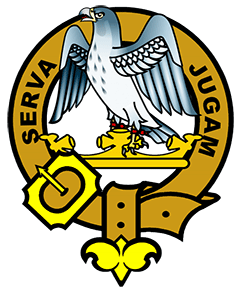Hay Clan
Hay Clan Crest: From a coronet, a falcon, armed, jessed and belled.
Hay Clan Motto: Serva Jugum (Keep the yoke).
Hay Clan History: Hay Clan History
There are two traditions surrounding the emergence of the Hay Family in Scotland. At the Battle of Luncarty which took place between the Scots and the Danes (c.973), Kenneth III was saved by one of his supporters
and his two sons. In gratitude, the King commanded that a falcon be let loose from Kinoull Hill and that as far as it flew, the lands would belong to his saviour. The bird's flight took in some of the best farmland
in the Carse.
The name Hay is also recorded in 8th century France where the La Haye de Puits were followers of the dukes of Normandy and accompanied William the Conqueror to England in 1066, presumably coming to Scotland with David I. In Scotland, William de Haye served William the Lion, and his son, also William, was among the hostages held in England during that King's reign. On his return to Scotland, he was granted the lands of Erroll in Perthshire. From William's younger brother Robert originate the Hays of Tweeddale who acquired their lands at Yester in East Lothian through marriage to the heiress of the 13th century wizard, Hugo de Gifford.
However, the family fortunes really took off during the reign of Robert the Bruce when Gilbert Hay, who had fought at Bannockburn in 1314, was appointed Hereditary Lord High Constable of Scotland and rewarded with the lands of Slains in Aberdeenshire.
In the 14th century, Sir Thomas Hay of Erroll married Elizabeth, daughter of Robert II. Another Sir Gilbert Hay, who fought in France with Joan of Arc against the English, is the ancestor of the Hays of Delgattie in Aberdeenshire. Sir William Hay of Delgattie was the Marquis of Montrose's Chief-of-Staff and executed in 1650. After the Restoration of Charles II he was awarded a State Funeral.
During the Reformation, the Hays remained Catholic and their castle of Old Slains was blown up under the personal supervision of James VI. However, throughout the Jacobite Uprisings of 1715 and 1745, they remained loyal to the Stuarts. The 13th Earl of Erroll was succeeded in the Celtic tradition by his daughter, and, on her death in 1758, the title passed to her great-nephew, James Boyd, whose father, the Earl of Kilmarnock, had been executed for treason in 1746. James henceforth assumed not only the Erroll earldom, but the Chiefship of the Clan.
John, 8th Lord Hay of Yester (1593-1654), was created Earl of Tweeddale in 1646. The 2nd Earl of Tweeddale (1625-97) , Chancellor of Scotland, was created Marquis of Tweeddale in 1694. The 2nd Marquis of Tweeddale (1645-1713) was Queen Anne's Commissioner to the Scottish Parliament and supported the Act of Union.
Edmund Hay (d.1591) was Rector of the Scots College at Port-à-Musson in France. Father Richard Augustine Hay (1661-1736) was Canon of Saint-Genevieve, Paris, and step-son of Sir William St Clair of Rosslyn. John Hay of Restalrig (d.1784) was Secretary to Prince Charles Edward Stuart in exile.
Places of Interest: Duns Castle, Duns, Berwickshire. A fortified keep was built here in the 14th century by Randolph, Earl of Moray. It passed to the Hays of Drumelzier in the 17th century.
Neidpath Castle, near Peebles. Overlooking the River Tweed, it was built for the de Hay family in the late 13th century. It was visited by Mary Queen of Scots and James VI, and is now owned by Wemyss Estates.
Park Castle, Glenluce, Wigtownshire. Built by Thomas Hay of Park, son of the Abbot of Glenluce in 1596.
Delgattie Castle, Turriff, Aberdeenshire. Magnificent sixteenth century castle restored as Clan Hay Centre.
Leith Hall, Kennethmont, Aberdeenshire. Home of the Leith-Hays. Today it is owned by the National Trust for Scotland.
Slains Castles (Old and New), Cruden Bay, Aberdeenshire. Both castles are ruins and are said to have inspired the author Bram Stoker when he was writing his novel Dracula.
Yester House, Gifford, East Lothian. Ancestral seat of the marquises of Tweeddale from 1704. It was sold by the widow of the 11th Marquis for tax reasons and is now privately owned.
Yester Castle, Gifford, East Lothian. Erected in 1268 by Hugo de Gifford, ancestor of the Hays of Yester. Sir Walter Scott mentions it in The Lay of the Last Minstrel. It is currently maintained by Historic Scotland.
Associated family names (Septs): Constable, Gifford, MacKester.
Clan Hay membership certificate.

